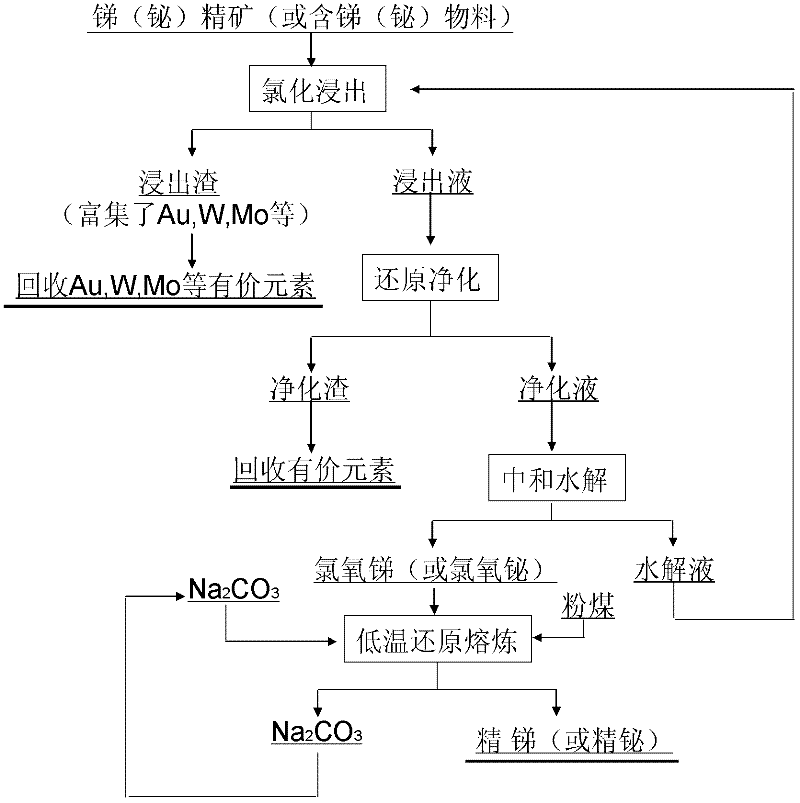Wet process-pyrogenic process joint smelting process for antimony or bismuth
A process and wet technology, applied in the field of antimony extraction, can solve the problems of complex equipment, high energy consumption, heavy pollution, etc.
- Summary
- Abstract
- Description
- Claims
- Application Information
AI Technical Summary
Problems solved by technology
Method used
Image
Examples
Embodiment 1
[0075] The composition of bismuth concentrate provided by a company in Hunan is: Bi 25.02%, WO 3 0.43%, Mo 3.17%, Fe 20.68%, SiO 2 6.33%, Cu 1.6%, S 26.5%.
[0076] Get the above-mentioned bismuth concentrate powder 100g, the liquid-solid ratio is 4:1, and the acidity of hydrochloric acid is 4mol·L -1 , oxidant NaClO 3 The amount of addition (in Bi 2 S 3 The consumption meter) is 1.5 times of the theoretical amount. After leaching for 3 hours under the condition of 70 ° C, the leaching temperature is 70 ° C. After leaching, filtration and separation, the washing liquid and the filtrate are combined, and the filter residue is dried and weighed. The bismuth content in the filtrate and the filter residue was analyzed, and the leaching rate of bismuth was obtained as 99.6% (in liquid) / 99.1% (in slag).
[0077] Analysis of impurities and Fe in the filtrate 3+ , Cu 2+ , Ag + 1.5 times the theoretical amount of bismuth powder was added to carry out reduction purification and...
Embodiment 2
[0081] The composition of antimony concentrate provided by a company in Hunan is: Sb 37.31%, Fe 13.68%, SiO 2 6.33%, Cu 4.6%, Au 8g t -1 , S26.5%.
[0082] Take 100g of the above-mentioned antimony concentrate powder, the liquid-solid ratio is 5:1, and the acidity of hydrochloric acid is 4.5mol·L -1 , oxidant SbCl 5 The amount of addition (in Sb 2 S 3 The consumption meter) is 2 times of the theoretical amount, the leaching temperature is 60 ℃ after leaching for 2 hours, filtration and separation, the washing liquid and the filtrate are combined, and the filter residue is dried and weighed. The antimony content in the filtrate and filter residue was analyzed, and the leaching rate of antimony was 98.9% (liquid) / 99.4% (slag), and the gold enrichment rate in the residue was 99.9%.
[0083] Analysis of the main impurity components and Fe in the filtrate 3+ , Cu 2+ The content of 1.2 times the theoretical amount of antimony sponge powder and ammonium sulfide was added to c...
Embodiment 3
[0087] A kind of bismuth-containing soot, bismuth is represented by Bi 2 O 3 form exists. The main components (%) are: Bi 4.23, Pb 41.30, Sn 3.01, Zn 1.0, Cu 1.7, As 2.3, S 9.7, Cd 0.12, In 0.016, Ag 0.01, Ge 0.02.
[0088] Take 10000g of above-mentioned bismuth soot powder, the liquid-solid ratio is 4:1, and the acidity of hydrochloric acid is 4mol·L -1 3. After leaching for 3 hours at a leaching temperature of 60°C, filter and separate, combine the washing liquid and filtrate, and dry and weigh the filter residue. The bismuth content in the filtrate and the filter residue was analyzed, and the leaching rate of bismuth was 96.2% (in liquid) / 95.5% (in slag).
[0089] Add 1.2 times the theoretical amount of thiourea as a reducing and purifying agent, and after reducing and purifying at room temperature for 40 minutes, filter and separate.
[0090] [Fe in the solution after reduction and purification 3+ ] and [Cu 2+ ] can reach below 0.01g / L.
[0091] At 50°C, add base NH...
PUM
 Login to View More
Login to View More Abstract
Description
Claims
Application Information
 Login to View More
Login to View More - R&D
- Intellectual Property
- Life Sciences
- Materials
- Tech Scout
- Unparalleled Data Quality
- Higher Quality Content
- 60% Fewer Hallucinations
Browse by: Latest US Patents, China's latest patents, Technical Efficacy Thesaurus, Application Domain, Technology Topic, Popular Technical Reports.
© 2025 PatSnap. All rights reserved.Legal|Privacy policy|Modern Slavery Act Transparency Statement|Sitemap|About US| Contact US: help@patsnap.com



